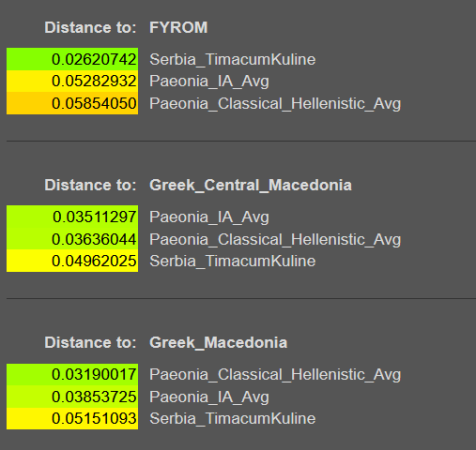Are these distances based on G25 coordinates?
They're the G25 averages of the ancient Paeonians sequenced in the southern arc study.
Even if so, what do these prove?
It concretely proves that there were already high steppe populations bordering Macedonia over a thousand years before the first Slavs would arrive to the Balkans. The Paeonians sequenced so far had individuals that were both totally normative to the modern Greek Macedonian average in the Hellenistic age and also a bit more northerly, similar to northern Italians in the Iron age.
To elaborate more it proves that this profile which we see in Greek Mainlanders long predates the arrival of the Slavs in this region. If we find the same profile normative to Greek Macedonia, it will effectively prove continuity from ancients to moderns with a distinct lack of far more northerly Slavic input.
Admixture and pca based distances are totally different aspects that aren't necessarily correlated and most of the time they aren't.
You can mix a Cypriot and an English and get an offspring that plots like North Italian.
Now replace these individuals with whole populations and after a while you will get even smoother admixture and distances with the North Italians.
The only way to tell them apart is if you model them against very ancient populations such as WHG, Iran_Neo, EHG and such.
You can model any population with an almost infinite number of mutually exclusive admixture scenarios with these tools, but that doesn't mean any of them actually happened or are accurate. Admixture modelling is just a "guess" and not definitive measure of ancestry by itself. These "guesses" only become evidenced when we begin to see historic/prehistoric samples published which show a broad introgression of genetic profiles which were previously uncommon to a given region, such was what we saw in Serbia in the Danubian frontier study. If said profiles become permanently normative or shift the average permanently it is assumed a measurable admixture scenario has affected the population.
By comparison distances are not really able to be manipulated like source populations. You plug in populations and compare them against one another. In this case the result we get is that the ancient Paeonians effectively overlap Modern Greek Mainlanders and Northern Italians. It's doubtful ancient Paeonian contributed anything to Italy, but the fact that they bordered Macedonia is significant. It implies long term and unaltered population continuity in the Greek Macedonia.
To cut story short, try model the Macedonian Greeks and the Paeonians with these ancients and put some heavy Balto-Slavic drifted sample in the mix.
I would really want to see the results. Try model them with any professional or amateurish tool available.
You can model them any number of ways as you've already mentioned. I don't really care too much about that. What's more important to answer this question is if the ancient samples show continuity throughout the ages in the same region or not. If we get a bunch of Modern Cretan-like ancient Macedonians who later turn out to form a cline with northern european and slavic populations in the middle ages which homogenize to a modern average then yes, your Slavic repopulation hypothesis would be evidenced.
But on the flip side scenario if ancient Macedonia turns up as Paeonian-like and we do not see a northward shift in this profile to present day then the repopulation hypothesis is thoroughly invalidated. Considering the Paeonians lived on the border of Macedonia itself, this expectation seems the most reasonable.
On the other hand, I'm not denying the Greeks any ancient ancestry, however to say that the Slavic ancestry is practically invisible in modern Macedonian Greeks is not very sustainable.
I don't think anyone here is denying the idea of Greeks having Greek ancestry at all, but are attempting to deny them the possibility of continuity with ancient Macedonians which is a standpoint that I find unsustainable based off of current evidence. I don't see significant Slavic contributions in modern Greek profiles.
No, those distances won't prove nothing I'm afraid. It will take more extensive research to get closer to the truth. A research involving both yDna, admixture and IBD matching.
The point was that the ancient profile average evidences a lot, not that it is a definitive answer by itself. The actual Greek Macedonian results if we ever get them will be much more definitive. aDNA recovery is in effect a process of mapping ancient populations and then comparing any later shifts in ancestry to prior norms. I think we all agree that we'd like to see more samples, but distance alone is far less biased than modelling guesswork which suffers from overfit and source population bias. I can't modify the distance here and neither can you.
I'm from FYROM if it makes you feel better that name.
I don't have any problem with your ethnic background to be clear. I just disagree with the idea of large amounts of Slavic input into Greece as things stand.


